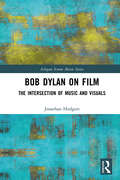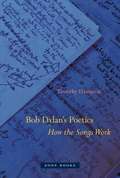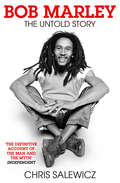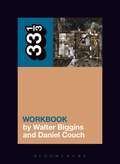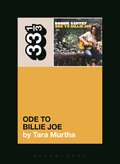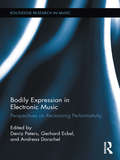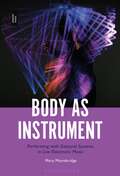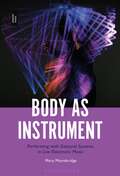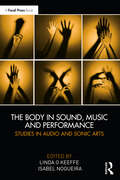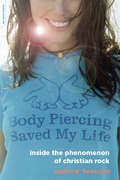- Table View
- List View
Bob Dylan in the Big Apple: Troubadour Tales of New York (Troubadour Tales #2)
by K G MilesThis is your travel guide through time and space to the favorite haunts of the most celebrated folkie on planet earth. Bob Dylan in the Big Apple takes you on Dylan's journey through the streets of New York - the locations, characters and stories that formed a backdrop to his life and work.Follow in his early footsteps to the Cafe Wha? and more recently the Beacon Theatre. With maps, illustrations and wonderful stories this is a must have for any Dylan enthusiast.
Bob Dylan on Film: The Intersection of Music and Visuals (Ashgate Screen Music Series)
by Jonathan HodgersIn May 1967, during a discussion about his yet-to-be-released film Eat the Document, Bob Dylan cryptically remarked, ‘The film is finished. It’s different.’ It would not be the last time he could make this claim. Beyond his musical prowess, Dylan’s career encompasses a lesser-explored facet – that of a filmmaker creating works that defy convention. This book delves into these cinematic forays, unravelling the intriguing interplay of Dylan’s presence both behind and in front of the camera.Dylan’s cinematic experiments, ranging from the ground-breaking Dont Look Back (1967) to the enigmatic Masked and Anonymous (2003), stand as unique and thought-provoking additions to his artistic legacy. Unveiling an experimental and inquisitive sensibility, these films draw inspiration not only from cinematic predecessors but also from Dylan’s songcraft. Often residing in the periphery of Dylan studies, a closer examination of his cinematic oeuvre reveals an underrated auteur who fearlessly transcends the boundaries of the page, stage, and screen.
Bob Dylan on Film: The Intersection of Music and Visuals (Ashgate Screen Music Series)
by Jonathan HodgersIn May 1967, during a discussion about his yet-to-be-released film Eat the Document, Bob Dylan cryptically remarked, ‘The film is finished. It’s different.’ It would not be the last time he could make this claim. Beyond his musical prowess, Dylan’s career encompasses a lesser-explored facet – that of a filmmaker creating works that defy convention. This book delves into these cinematic forays, unravelling the intriguing interplay of Dylan’s presence both behind and in front of the camera.Dylan’s cinematic experiments, ranging from the ground-breaking Dont Look Back (1967) to the enigmatic Masked and Anonymous (2003), stand as unique and thought-provoking additions to his artistic legacy. Unveiling an experimental and inquisitive sensibility, these films draw inspiration not only from cinematic predecessors but also from Dylan’s songcraft. Often residing in the periphery of Dylan studies, a closer examination of his cinematic oeuvre reveals an underrated auteur who fearlessly transcends the boundaries of the page, stage, and screen.
Bob Dylan: The Stories Behind the Songs, 1962-69 (Stories Behind The Songs Ser.)
by Andy GillIn this book, Andy Gill assesses the circumstances behind Dylan's most famous songs, tracing the artist's progress from young tyro folkie to acclaimed protest singer, and through the subsequent changes which saw him invent folk-rock and transform rock 'n' roll with symbolist poetry, before retreating into country-tinged conservatism just as his followers were engaged in the great psychedelic freak-show of the late 1960s. Even then, he couldn't help but innovate, introducing the world to another strain of popular music-country-rock-which would come to dominate the American charts through the next decade.Always one step ahead of the crowd, always pushing himself to extend the boundaries of his art, the Dylan of the 1960s remains a beacon of integrity to which fans and fellow musicians keep returning.
Bob Dylan's Highway 61 Revisited (33 1/3)
by Mark PolizzottiHighway 61 Revisited resonates because of its enduring emotional appeal. Few songwriters before Dylan or since have combined so effectively the intensely personal with the spectacularly universal. In "Like a Rolling Stone," his gleeful excoriation of Miss Lonely (Edie Sedgwick? Joan Baez? a composite "type"?) fuses with the evocation of a hip new zeitgeist to produce a veritable anthem. In "Ballad of a Thin Man," the younger generation's confusion is thrown back in the Establishment's face, even as Dylan vents his disgust with the critics who labored to catalogue him. And in "Desolation Row," he reaches the zenith of his own brand of surrealist paranoia, that here attains the atmospheric intensity of a full-fledged nightmare. Between its many flourishes of gallows humor, this is one of the most immaculately frightful songs ever recorded, with its relentless imagery of communal executions, its parade of fallen giants and triumphant local losers, its epic length and even the mournful sweetness of Bloomfield's flamenco-inspired fills. In this book, Mark Polizzotti examines just what makes the songs on Highway 61 Revisited so affecting, how they work together as a suite, and how lyrics, melody, and arrangements combine to create an unusually potent mix. He blends musical and literary analysis of the songs themselves, biography (where appropriate) and recording information (where helpful). And he focuses on Dylan's mythic presence in the mid-60s, when he emerged from his proletarian incarnation to become the American Rimbaud. The comparison has been made by others, including Dylan, and it illuminates much about his mid-sixties career, for in many respects Highway 61 is rock 'n' roll's answer to A Season in Hell.
Bob Dylan's Poetics: How the Songs Work (Zone Bks.)
by Timothy HamptonBob Dylan’s reception of the 2016 Nobel Prize for Literature has elevated him beyond the world of popular music, establishing him as a major modern artist. However, until now, no study of his career has focused on the details and nuances of the songs, showing how they work as artistic statements designed to create meaning and elicit emotion. Bob Dylan’s Poetics: How the Songs Work is the first comprehensive book on both the poetics and politics of Dylan’s compositions. It studies Dylan, not as a pop hero, but as an artist, as a maker of songs. Focusing on the interplay of music and lyric, it traces Dylan’s innovative use of musical form, his complex manipulation of poetic diction, and his dialogues with other artists, from Woody Guthrie to Arthur Rimbaud. Moving from Dylan’s earliest experiments with the blues, through his mastery of rock and country, up to his densely allusive recent recordings, Timothy Hampton offers a detailed account of Dylan’s achievement. Locating Dylan in the long history of artistic modernism, the book studies the relationship between form, genre, and the political and social themes that crisscross Dylan’s work. Bob Dylan’s Poetics: How the Songs Work offers both a nuanced engagement with the work of a major artist and a meditation on the contribution of song at times of political and social change.
Bob Marley: The Untold Story
by Chris SalewiczWhat was it about Bob Marley that made him so popular in a world dominated by rock’n’roll? How is that he has not only remained the single most successful reggae artist ever, but has also become a shining beacon of radicalism and peace to generation after generation of fans across the globe?
Bob Mould's Workbook (33 1/3)
by Walter Biggins Daniel CouchIn 1989, Bob Mould took a left turn. Already legendary before his 30th birthday for his noise-and-nuance work in Hüsker Dü, Mould had recently walked away from his old band. He re-emerged with his debut solo album: Workbook. Filled with chiming acoustic guitars, multitracked vocals, pristine production, and even a cello, Workbook was both admired and questioned for Mould's perceived departure from his post-punk roots. Three decades later, the album has emerged as a key for understanding the nascent alternative rock genre and the concerns Mould would explore for the duration of his career. Fusing post-punk sound and confessional lyrics with a richer emotional and musical range, Mould's Workbook merged worlds that seemed unbridgeable at the time. Alternative rock emerged from the wreckage of the 1980s, and Workbook was a model for the genre's maturation. Workbook serves its title in two ways-as a map for musicians to follow into a new mode, and as a journal of Mould's struggle toward adulthood. It opens conversations about rock, identity, spirituality, authenticity, and the perils and promises of mainstream culture. Walter Biggins and Daniel Couch, two critics who grew up with Workbook, extend these conversations-through letters and emails to each other, and through correspondence with Mould and Workbook's musicians and producers. That crosstalk leads to, through this seminal album, a deeper understanding of "alternative rock†? at the moment of its inception, just before it took over the radio.
Bob Mould's Workbook (33 1/3)
by Walter Biggins Daniel CouchIn 1989, Bob Mould took a left turn. Already legendary before his 30th birthday for his noise-and-nuance work in Hüsker Dü, Mould had recently walked away from his old band. He re-emerged with his debut solo album: Workbook. Filled with chiming acoustic guitars, multitracked vocals, pristine production, and even a cello, Workbook was both admired and questioned for Mould's perceived departure from his post-punk roots. Three decades later, the album has emerged as a key for understanding the nascent alternative rock genre and the concerns Mould would explore for the duration of his career. Fusing post-punk sound and confessional lyrics with a richer emotional and musical range, Mould's Workbook merged worlds that seemed unbridgeable at the time. Alternative rock emerged from the wreckage of the 1980s, and Workbook was a model for the genre's maturation. Workbook serves its title in two ways-as a map for musicians to follow into a new mode, and as a journal of Mould's struggle toward adulthood. It opens conversations about rock, identity, spirituality, authenticity, and the perils and promises of mainstream culture. Walter Biggins and Daniel Couch, two critics who grew up with Workbook, extend these conversations-through letters and emails to each other, and through correspondence with Mould and Workbook's musicians and producers. That crosstalk leads to, through this seminal album, a deeper understanding of “alternative rock” at the moment of its inception, just before it took over the radio.
Bobbie Gentry's Ode to Billie Joe (33 1/3)
by Tara MurthaJuly, 1967: It seems the entire country stopped to listen to a husky voice steeped in the simmering secrets of the South tell a tragic tale of teenage suicide. So much for the Summer of Love. "Ode to Billie Joe†? knocked the Beatles' "All You Need is Love†? off the top of the charts, and Bobbie Gentry became an international star. Almost 50 years later, Gentry is as enigmatic and captivating as her signature song. Of course, fans still want to know why Billie Joe McAllister jumped off the Tallahatchie Bridge. They also wonder: Why did Bobbie Gentry, who has not performed or made a public appearance since the early 1980s, leave it all behind? Through extensive interviews and unprecedented access to career memorabilia, Murtha explores the real-life mysteries ensnarled within the much-disputed origin of Ode to Billie Joe. The result is an investigative pop history that reveals, for the first time, the full breadth of Bobbie Gentry's groundbreaking career-and just may help explain her long silence. Foreword by musician Jill Sobule.
Bobbie Gentry's Ode to Billie Joe (33 1/3)
by Tara MurthaJuly, 1967: It seems the entire country stopped to listen to a husky voice steeped in the simmering secrets of the South tell a tragic tale of teenage suicide. So much for the Summer of Love. “Ode to Billie Joe” knocked the Beatles' “All You Need is Love” off the top of the charts, and Bobbie Gentry became an international star. Almost 50 years later, Gentry is as enigmatic and captivating as her signature song. Of course, fans still want to know why Billie Joe McAllister jumped off the Tallahatchie Bridge. They also wonder: Why did Bobbie Gentry, who has not performed or made a public appearance since the early 1980s, leave it all behind? Through extensive interviews and unprecedented access to career memorabilia, Murtha explores the real-life mysteries ensnarled within the much-disputed origin of Ode to Billie Joe. The result is an investigative pop history that reveals, for the first time, the full breadth of Bobbie Gentry's groundbreaking career-and just may help explain her long silence. Foreword by musician Jill Sobule.
Bodies, Noise and Power in Industrial Music (Pop Music, Culture and Identity)
by Jason Whittaker Elizabeth PotterThis edited collection delves into the industrial music genre, exploring the importance of music in (sub)cultural identity formation, and the impact of technology on the production of music. With its roots as early as the 1970s, industrial music emerged as a harsh, transgressive, and radically charged genre. The soundscape of the industrial is intense and powerful, adorned with taboo images, and thematically concerned with authority and control. Elemental to the genre is critical engagement with configurations of the body and related power. Adopting an interdisciplinary approach, this collection analyses the treatment of subjects like the Body (animal, human, machine), Noise (rhythmic, harsh) and Power (authority, institutions, law) in a variety of industrial music’s elements. Throughout the collection, these three subjects are interrogated by examining lyrics, aesthetics, music videos, song writing, performance and audience reception. The chapters have been carefully selected to produce a diverse and intersectional perspective, including work on Black industrial musicians and Arabic and North African women’s collaborations. Rather than providing historical context, the contributors interpret the finer elements of the aesthetics and discourses around physical bodies and power as expressed in the genre, expanding the ‘industrial’ boundary and broadening the focus beyond white European industrial music.
Bodies of Sound: Studies Across Popular Music and Dance (Ashgate Popular and Folk Music Series)
by Susan C. Cook Sherril DoddsFrom the ragtime one-step of the early twentieth century to the contemporary practices of youth club cultures, popular dance and music are inextricably linked. This collection reveals the intimate connections between the corporeal and the sonic in the creation, transmission and reception of popular dance and music, which is imagined here as ’bodies of sound’. The volume provokes a wide-ranging, interdisciplinary conversation that includes scholarship from Asia, Europe and the United States, which explores topics from the nineteenth century through to the present day and engages with practices at local, national and transnational levels. In Part I: Constructing the Popular, the authors explore how categories of popular music and dance are constructed and de-stabilized, and their proclivity to appropriate and re-imagine cultural forms and meanings. In Part II: Authenticity, Revival and Reinvention, the authors examine how popular forms produce and manipulate identities and meanings through their attraction to and departure from cultural traditions. In Part III: (Re)Framing Value, the authors interrogate how values are inscribed, silenced, rearticulated and capitalized through popular music and dance. And in Part IV: Politics of the Popular, the authors read the popular as a site of political negotiation and transformation.
Bodies of Sound: Studies Across Popular Music and Dance (Ashgate Popular and Folk Music Series)
by Sherril Dodds Susan C. CookFrom the ragtime one-step of the early twentieth century to the contemporary practices of youth club cultures, popular dance and music are inextricably linked. This collection reveals the intimate connections between the corporeal and the sonic in the creation, transmission and reception of popular dance and music, which is imagined here as ’bodies of sound’. The volume provokes a wide-ranging, interdisciplinary conversation that includes scholarship from Asia, Europe and the United States, which explores topics from the nineteenth century through to the present day and engages with practices at local, national and transnational levels. In Part I: Constructing the Popular, the authors explore how categories of popular music and dance are constructed and de-stabilized, and their proclivity to appropriate and re-imagine cultural forms and meanings. In Part II: Authenticity, Revival and Reinvention, the authors examine how popular forms produce and manipulate identities and meanings through their attraction to and departure from cultural traditions. In Part III: (Re)Framing Value, the authors interrogate how values are inscribed, silenced, rearticulated and capitalized through popular music and dance. And in Part IV: Politics of the Popular, the authors read the popular as a site of political negotiation and transformation.
Bodily Expression in Electronic Music: Perspectives on Reclaiming Performativity (Routledge Research in Music)
by Deniz Peters, Gerhard Eckel and Andreas DorschelIn this book, scholars and artists explore the relation between electronic music and bodily expression from perspectives including aesthetics, philosophy of mind, phenomenology, dance and interactive performance arts, sociology, computer music and sonic arts, and music theory, transgressing disciplinary boundaries and established beliefs. The historic decoupling of action and sound generation might be seen to have distorted or even effaced the expressive body, with the retention of performance qualities via recoupling not equally retaining bodily expressivity. When, where, and what is the body expressed in electronic music then? The authors of this book reveal composers’, performers’, improvisers’ and listeners’ bodies, as well as the works’ and technologies’ figurative bodies as a rich source of expressive articulation. Bringing together humanities’ scholarship and musical arts contingent upon new media, the contributors offer inspiring thought and critical reflection for all those seriously engaged with the aesthetics of electronic music, interactive performance, and the body’s role in aesthetic experience and expression. Performativity is not only seen as being reclaimed in live electronic music, interactive arts, and installations; it is also exposed as embodied in the music and the listeners themselves.
Bodily Expression in Electronic Music: Perspectives on Reclaiming Performativity (Routledge Research in Music)
by Deniz Peters Gerhard Eckel Andreas DorschelIn this book, scholars and artists explore the relation between electronic music and bodily expression from perspectives including aesthetics, philosophy of mind, phenomenology, dance and interactive performance arts, sociology, computer music and sonic arts, and music theory, transgressing disciplinary boundaries and established beliefs. The historic decoupling of action and sound generation might be seen to have distorted or even effaced the expressive body, with the retention of performance qualities via recoupling not equally retaining bodily expressivity. When, where, and what is the body expressed in electronic music then? The authors of this book reveal composers’, performers’, improvisers’ and listeners’ bodies, as well as the works’ and technologies’ figurative bodies as a rich source of expressive articulation. Bringing together humanities’ scholarship and musical arts contingent upon new media, the contributors offer inspiring thought and critical reflection for all those seriously engaged with the aesthetics of electronic music, interactive performance, and the body’s role in aesthetic experience and expression. Performativity is not only seen as being reclaimed in live electronic music, interactive arts, and installations; it is also exposed as embodied in the music and the listeners themselves.
Body and Force in Music: Metaphoric Constructions in Music Psychology (SEMPRE Studies in The Psychology of Music)
by Youn KimOur understanding of music is inherently metaphorical, and metaphoricity pervades all sorts of musical discourses, be they theoretical, analytical, philosophical, pedagogical, or even scientific. The notions of "body" and "force" are the two most pervasive and comprehensive scientific metaphors in musical discourse. Throughout various intertwined contexts in history, the body–force pair manifests multiple layers of ideological frameworks and permits the conceptualization of music in a variety of ways. Youn Kim investigates these concepts of body and force in the emerging field of music psychology in the late nineteenth and early twentieth centuries. The field’s discursive space spans diverse contexts, including psychological theories of auditory perception and cognition, pedagogical theories on the performer’s bodily mechanism, speculative and practical theories of musical rhythm, and aesthetical discussion of the power of music. This investigation of body and force aims to illuminate not just the past scene of music psychology but also the notions of music that are being constructed at present.
Body and Force in Music: Metaphoric Constructions in Music Psychology (SEMPRE Studies in The Psychology of Music)
by Youn KimOur understanding of music is inherently metaphorical, and metaphoricity pervades all sorts of musical discourses, be they theoretical, analytical, philosophical, pedagogical, or even scientific. The notions of "body" and "force" are the two most pervasive and comprehensive scientific metaphors in musical discourse. Throughout various intertwined contexts in history, the body–force pair manifests multiple layers of ideological frameworks and permits the conceptualization of music in a variety of ways. Youn Kim investigates these concepts of body and force in the emerging field of music psychology in the late nineteenth and early twentieth centuries. The field’s discursive space spans diverse contexts, including psychological theories of auditory perception and cognition, pedagogical theories on the performer’s bodily mechanism, speculative and practical theories of musical rhythm, and aesthetical discussion of the power of music. This investigation of body and force aims to illuminate not just the past scene of music psychology but also the notions of music that are being constructed at present.
Body as Instrument: Performing with Gestural Systems in Live Electronic Music
by Mary MainsbridgeBody as Instrument explores how musicians interact with movement-controlled performance systems, producing sounds imbued with their individual physical signature. Using motion tracking technology, performers can translate physical actions into sonic processes, creating or adapting novel gestural systems that transcend the structures and constraints of conventional musical instruments. Interviews with influential artists in the field, Laetitia Sonami, Atau Tanaka, Pamela Z, Julie Wilson-Bokowiec, Lauren Sarah Hayes, Mark Coniglio, Garth Paine and The Bent Leather Band expose the transformational impact of motion sensors on musicians' body awareness and abilities. Coupled with reflection on author-composed works, the book analyses how the body as instrument metaphor informs relationships between performers, their bodies and self-designed instruments. It also examines the role of experiential design strategies in developing robust and nuanced gestural systems that mirror a performer's movement habits, preferences and skills, inspiring new physical forms of musical communication and diverse musical repertoire.
Body as Instrument: Performing with Gestural Systems in Live Electronic Music
by Mary MainsbridgeBody as Instrument explores how musicians interact with movement-controlled performance systems, producing sounds imbued with their individual physical signature. Using motion tracking technology, performers can translate physical actions into sonic processes, creating or adapting novel gestural systems that transcend the structures and constraints of conventional musical instruments. Interviews with influential artists in the field, Laetitia Sonami, Atau Tanaka, Pamela Z, Julie Wilson-Bokowiec, Lauren Sarah Hayes, Mark Coniglio, Garth Paine and The Bent Leather Band expose the transformational impact of motion sensors on musicians' body awareness and abilities. Coupled with reflection on author-composed works, the book analyses how the body as instrument metaphor informs relationships between performers, their bodies and self-designed instruments. It also examines the role of experiential design strategies in developing robust and nuanced gestural systems that mirror a performer's movement habits, preferences and skills, inspiring new physical forms of musical communication and diverse musical repertoire.
Body Count's Body Count (33 1/3)
by Ben ApatoffOn Ice-T's 1991 classic O.G. Original Gangster, he introduced his all-Black hardcore band Body Count with lead guitarist Ernie C, bringing them on the first-ever Lollapalooza tour that summer. The next year, Body Count's self-titled debut album, rounded out by rhythm guitarist D-Roc the Executioner, bassist Mooseman, and drummer Beatmaster V, made them the most incendiary band in the world, confronting white supremacy and police brutality with pulverizing songs that shattered musical boundaries. Body Count's rage and shock humor sparked nationwide protests and boycotts, including death threats, censure from the federal government, a spot on the FBI National Threat list, and a denunciation by the President of the United States. The album was removed from stores and remains banned to this day, but decades later Body Count are performing to theirbiggest audiences and greatest acclaim, pulling off one of the most remarkable comebacks in punk or metal history.Drawn from years of research and dozens of new interviews, this is the story of a band of high school friends who revolutionized modern music, brought explosive live performances, and raised questions America's lawmakers didn't want to answer, overcoming some of the country's most powerful forces to reshape the world's cultural conversation.
Body Count's Body Count (33 1/3)
by Ben ApatoffOn Ice-T's 1991 classic O.G. Original Gangster, he introduced his all-Black hardcore band Body Count with lead guitarist Ernie C, bringing them on the first-ever Lollapalooza tour that summer. The next year, Body Count's self-titled debut album, rounded out by rhythm guitarist D-Roc the Executioner, bassist Mooseman, and drummer Beatmaster V, made them the most incendiary band in the world, confronting white supremacy and police brutality with pulverizing songs that shattered musical boundaries. Body Count's rage and shock humor sparked nationwide protests and boycotts, including death threats, censure from the federal government, a spot on the FBI National Threat list, and a denunciation by the President of the United States. The album was removed from stores and remains banned to this day, but decades later Body Count are performing to theirbiggest audiences and greatest acclaim, pulling off one of the most remarkable comebacks in punk or metal history.Drawn from years of research and dozens of new interviews, this is the story of a band of high school friends who revolutionized modern music, brought explosive live performances, and raised questions America's lawmakers didn't want to answer, overcoming some of the country's most powerful forces to reshape the world's cultural conversation.
The Body in Sound, Music and Performance: Studies in Audio and Sonic Arts
by Linda O KeeffeThe Body in Sound, Music and Performance brings together cutting-edge contributions from women working on and researching contemporary sound practice. This highly interdisciplinary book features a host of international contributors and places emphasis on developments beyond the western world, including movements growing across Latin America. Within the book, the body is situated as both the site and centre for knowledge making and creative production. Chapters explore how insightful theoretical analysis, new methods, innovative practises, and sometimes within the socio-cultural conditions of racism, sexism and classicism, the body can rise above, reshape and deconstruct understood ideas about performance practices, composition, and listening/sensing. This book will be of interest to both practitioners and researchers in the fields of sonic arts, sound design, music, acoustics and performance.
The Body in Sound, Music and Performance: Studies in Audio and Sonic Arts
by Linda O Keeffe Isabel NogueiraThe Body in Sound, Music and Performance brings together cutting-edge contributions from women working on and researching contemporary sound practice. This highly interdisciplinary book features a host of international contributors and places emphasis on developments beyond the western world, including movements growing across Latin America. Within the book, the body is situated as both the site and centre for knowledge making and creative production. Chapters explore how insightful theoretical analysis, new methods, innovative practises, and sometimes within the socio-cultural conditions of racism, sexism and classicism, the body can rise above, reshape and deconstruct understood ideas about performance practices, composition, and listening/sensing. This book will be of interest to both practitioners and researchers in the fields of sonic arts, sound design, music, acoustics and performance.
Body Piercing Saved My Life: Inside the Phenomenon of Christian Rock
by Andrew BeaujonBody Piercing Saved My Life is the first in-depth journalistic investigation into a subculture so large that it's erroneous to even call it a subculture: Christian rock. Christian rock culture is booming, not only with bands but with extreme teen Bibles, skateboarding ministries, Christian tattoo parlors, paintball parks, coffeehouses, and nightclubs,encouraging kids to form their own communities apart from the mainstream. Profiling such successful Christian rock bands as P.O.D., Switchfoot, Creed, Evanescence, and Sixpence None the Richer, as well as the phenomenally successful Seattle Christian record label Tooth & Nail, enormous Christian rock festivals, and more, Spin journalist Andrew Beaujon lifts the veil on a thriving scene that operates beneath the secular world's radar. Revealing, sympathetic, and groundbreaking, Body Piercing Saved My Life (named for a popular Christian rock T-shirt depicting Christ's wounds) is a fascinating look into the hearts and minds of an enormous, and growing, youth culture.

